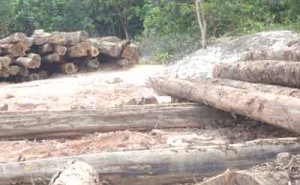Economy fails to meet 3.4 % growth rate for 2015 – Finance Minister
…Forestry sector takes hardest blow in recent years
…Construction and Bauxite growth targets fell through
By: Kiana Wilburg
The projected growth rate of 3.4 percent for 2015 was not achieved. This is according to Finance Minister Winston Jordan , who stated that a modest estimate of two to three percent was realized. A number of reasons were blamed for this.
Jordan said that apart from three sectors, which generally performed poorly, getting the economy into acceleration mode after the May 2015 elections proved to be a major challenge.
He said, “The economy after the elections was slow and this impacted the growth. The 3.4 percent growth rate was not met. We banked a lot on the Public Sector Investment Programme, which we hoped would have picked up rapidly but many of them are still in the preliminary stages. We were faced with a number of implementation problems and as a result of this, work got underway later than projected, so the construction sector really fell down badly.”
With regard to the plans for the construction sector, a number of projects were outlined. Jordan in his maiden budget speech had announced that Government intends to ensure the construction of new road links, particularly a road linking the two international airports that provides an alternative option to the East Bank Highway; and the linking of the city and coastland to the new townships of Bartica, Mahdia and Lethem. He said, too, that Government would be seeking to develop a more creative and cost-effective investment model to construct a new fixed bridge across the Demerara River.
In 2015, the sum of $13 billion was allocated for enhancing the roads and bridges network throughout Guyana. In an effort to ease congestion and reduce travel time, the Government proposed urgent expansion of the East Coast Demerara Highway. Additionally, over $1.6 Billion was budgeted for the upgrade of the Sheriff Street/Mandela Avenue Road, in order to make it a modern thoroughfare for Georgetown. 
Further, a total of $1.2 Billion was budgeted for the completion of the East Bank Demerara Highway, which provides improved transit from Providence to Great Diamond.
The Finance Minister had also disclosed Government’s plans to link the Sheriff Street/Mandela Avenue urban development to peri-urban communities. He said that Government would be investing $387 million to upgrade the Sophia “Ring Road”.
Jordan had said that Rural development will materialize through investments of $544 million to upgrade community roads and bridges in the 10 Administrative Regions. Similarly, a provision of $1.2 billion was made to upgrade more than 28 km of farm-to-market access roads and bridges located in Laluni, Onverwagt, Parika and Ruby Backdams.
The Finance Minister had said that Government would also construct a road link between Parika and Goshen that will provide an alternative access route to Bartica; construct all weather roads in Regions Seven and Nine, to open new opportunities to exploit Guyana’s natural resources and upgrade internal roads in the proposed new towns of Bartica, Mahdia and Mabaruma.
Another disappointing sector identified by Jordan was Forestry. He said that the projections for this area were optimistic but it did not perform as expected.
He said, “This sector had one of the hardest hits in recent times. We expected it to pick up but it did not. Another disappointment was the Bauxite sector. That too, fell short of our expectations. But for 2015, sugar, rice and gold performed well.”
In his 2015 Budget speech, Jordan noted the Forestry Sector’s performance in 2014 and the problems and issues encountered in the sector. Based on those concerns, he said that the Government will undertake a thorough review of the Investment Agreements for this sector to ensure that there is compliance with Regulations and the Agreements and to ensure sustainable harvesting of the forestry product.
He noted that the original projection in January, 2015, was for the 2014 production levels to be sustained. However, forestry production was down by 9.8 percent in mid 2015. As a consequence, the sector’s performance for 2015 was downgraded from January’s projection of zero growth to a negative 1.3 percent.
As for the early projections for growth in bauxite, it was pegged at a 10.3 percent recovery, in 2015. This was after two consecutive years of decline in 2013 and 2014. Strengthening of world market demand and prices were the key premises informing this projection.
Output was targeted at 1,754 thousand tonnes, up from the 1,564 thousand, in 2014. Jordan recalled that not unlike what was earlier seen in the other sectors, output at midway point in 2015 of 747,542 tonnes was actually 14.8 percent below the first half production in 2014.
As a consequence, total output was scaled back to a more realistic 1,635 thousand tonnes, predominated by the lower value grades of bauxite. This represents a negative growth for 2015 of 5.7 percent.
Jordan however projected a three to four percent growth for 2016.

